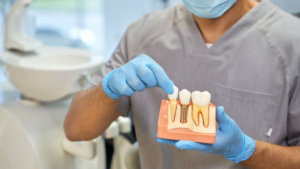It’s fair to say that the engineering of dental implants and their introduction to the market was a landmark moment in the history of dentistry. Having a dental implant placed allows patients to receive a fixed tooth replacement option that behaves and feels like a real tooth.
What are dental implants?
The role of an implant is to be a replacement for a lost tooth root. Made from titanium, implants are exceptionally compatible with the human body, making this metal an ideal choice for their manufacturing. Whilst titanium rejection can occur due to allergies, this is very rare. Approximately 0.6% of the population is thought to have a titanium allergy.
Beginnings going back centuries
Our ancestors used very basic methods to achieve tooth replacement. One such example was displayed in the mouth of a Mayan woman discovered by archaeologists, who found that she had a piece of carved shell in the shape of a tooth inserted into the socket of a missing tooth. Meanwhile, the Ancient Egyptians and Romans were also known to use crude ways of replacing missing teeth and part of missing teeth.
It wasn’t until 1952 that the implants we know today began to make waves.
Modern implants
The implants of today work via a process known as osseointegration, which is when the bone and the titanium implant merge together. This generally happens over a period ranging between 3-9 months. Once complete, the bone and implant can function harmoniously, as the body readily accepts the implant as if it were a natural entity.
But the osseointegration process supposedly happened by accident! Whilst testing titanium oculars in the bones of rabbits as a healing aid for broken human bones, Swedish orthopaedic surgeon Per Ingvar Branemark had an unexpected revelation. Once he came to making an in-depth analysis, he saw that the bone had in fact, infused with the titanium. And so, later that year, he placed the very first implant using the osseointegration procedure.
In 1959 the titanium screw is born
By 1959, a patented titanium screw had been developed by Italian dentist Dr Stefano Melchaide Tramonte and used it to support his own prosthesis. This is the contemporary implant as we know it today. Implants are still titanium screws in 2022, and approximately 10,000 implants are placed in the U.K every single year.
Cutting-edge modern implant technology
The technology and engineering of dental implants has continued to grow, benefitting dentists and patients alike.
The planning stages of having a dental implant are crucial to ensuring their placement is successful. The more thorough we are as dentists with planning implant cases, the better the treatment outcome will be and here at 92 Dental, we plan for every possible outcome so that nothing is left to chance. Using a CBCT scanner in combination with digital impressions allows us to create a simple digital plan that generates precise measurements of your jawbone and an optical model of your soft tissues, teeth and bones. This allows us to have a clear picture of how your bite functions, and with special imaging software at our disposal, we can better explain your treatment instead of giving only a spoken explanation.
Implant surgeries and their impact
To undergo the dental implant process, patients must have enough healthy bone to support the implant. Using the CBCT scanner, we can identify if this is the case. Should we find it is not, there are surgical procedures such as a bone graft and a sinus lift that can be performed, which use your own bone or a donor’s bone.
Another solution to low bone density is to place a material that stimulates bone regeneration (usually either Geistlich Bio-Oss® or EthOss®) into the affected area.
Thanks to these amazing methods, patients with low jaw bone density no longer have the opportunity of getting dental implants closed off to them.
Why choose dental implants as a mode of tooth replacement?
Dental implants stand a cut above the rest. They’re the premium tooth replacement treatment and when you study the benefits they can bring, it’s no surprise why.
Dental implants can:
– Emulate the exact appearance and function of real teeth.
– Offer a fixed solution to lost teeth.
– Support dentures in place, making them more stable and, therefore, effective.
– Support the jawbone by making a direct connection with it during the healing period. This allows the jawbone to stay strong, functional and able to uphold your facial structure.
Dental implants near Chiswick
Our Hammersmith-based dental practice welcomes patients from all across London, including Chiswick. If you’re based in Chiswick and looking for a reputable dental implant dental practice, you can rely on 92 Dental to deliver outstanding treatment.
Our implant surgeons have placed thousands of implants, having worked in practices across London for over 15 years. They also possess extensive post-graduate training in periodontics (the diagnosis and treatment of gum disease), which plays an important role in the treatment planning stages of implant surgery. As periodontitis is the most common reason why implants fail, this knowledge is crucial to ensuring implant treatments are a success for our patients.
If you would like to book yourself in for a dental implant consultation, please contact our friendly team today. We also offer 0% finance to help you spread the cost of treatment should you need to. Find out more by filling out this quick and easy form, where your rate will be calculated.





